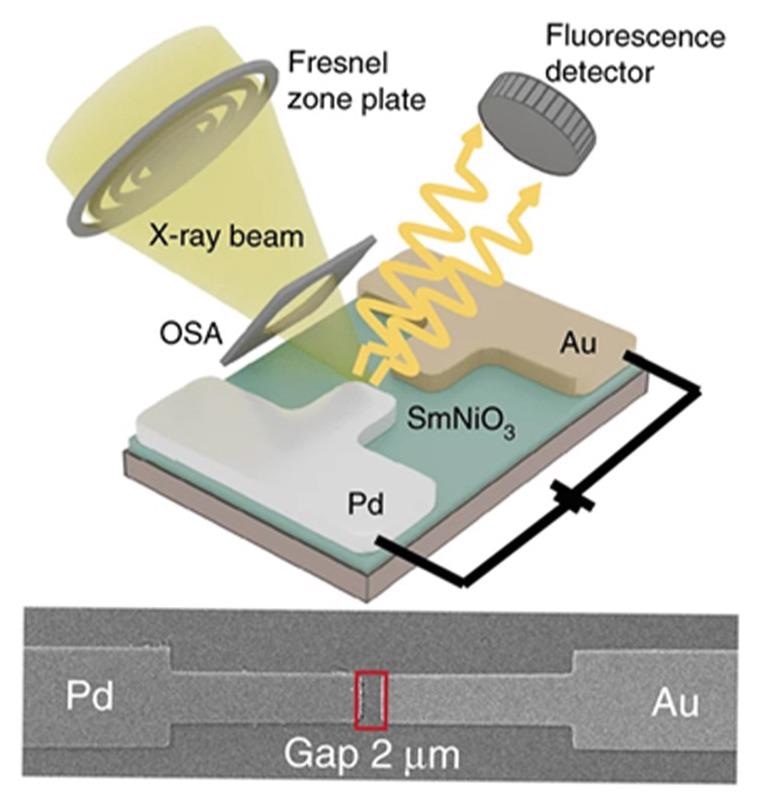Mar 3 2021
Artificial intelligence (AI) needs a large amount of computing power and also multipurpose hardware to support this computing power.
 The collaborative research team utilized the powerful X-ray nanoprobe imaging tool to study the NdNiO₃ device showing neuron tree-like memory. A scanning electron microscope image of the NdNiO₃ device is shown at the bottom. The red rectangle shows the scanned area of the X-ray imaging. Image Credit: by Argonne National Laboratory.
The collaborative research team utilized the powerful X-ray nanoprobe imaging tool to study the NdNiO₃ device showing neuron tree-like memory. A scanning electron microscope image of the NdNiO₃ device is shown at the bottom. The red rectangle shows the scanned area of the X-ray imaging. Image Credit: by Argonne National Laboratory.
However, the majority of the AI-supportive hardware is based around the same ancient technology and is still a long way from simulating the neural activity in the human brain.
In an attempt to overcome this issue, a research team from across the country, headed by Professor Shriram Ramanathan from Purdue University, has identified a new approach to make the hardware more sustainable and efficient.
Together with his research team, Ramanathan utilized quantum materials—whose properties work beyond the boundaries of traditional physics—to design a device that can sort data efficiently and rapidly. Researchers from the Argonne National Laboratory at the Department of Energy (DOE), Brookhaven Laboratory (BNL) at DOE, and the University of California, San Diego, helped Professor Ramanathan learn how this device actually works.
Professor Ramanathan and his research team initiated their experiment by adding a proton into a quantum material, known as neodymium nickel oxide (NdNiO3). They soon found out that when an electric pulse is applied to the material, it causes the proton to move.
The team also learned that every new position of the proton generated a varied resistance state, which, in turn, created a data storage site known as a memory state. Numerous electric pulses produced a branch composed of memory states, imitating the “tree-like” memory process of the human brain.
This discovery opens up new frontiers for AI that have been largely ignored because the ability to implement this kind of intelligence into electronic hardware has not existed.
Shriram Ramanathan, Professor, Purdue University
Professor Ramanathan and his research team opted to work with NdNiO3 because of its special magnetic and electronic properties. One of the most fascinating behaviors of NdNiO3 is its metal-to-insulator transition (MIT), for which the properties change drastically from allowing free-flowing energy (such as metal) to inhibiting the current (such as plastic or ceramic) by altering the temperature.
This special MIT behavior has immense potential in electronic devices for memory and computing. To demonstrate the MIT process in NdNiO3, Professor Ramanathan doped protons into the material instead of altering the temperature in this latest study. He and his research team are the first to accomplish this feat.
Before this finding, this neuron “tree-like” network had only been visualized in hardware that worked at temperatures much lower for viable applications, somewhere between liquid nitrogen and dry ice.
After Professor Ramanathan’s team created the novel device, researchers from the Advanced Photon Source (APS) and Center for Nanoscale Materials (CNM)—both DOE Office of Science User Facilities at Argonne—examined the electronic and structural evolution in the material used for constructing it. Material characterization as well as the working mechanism of the material was performed at APS beamlines 26-ID and 33-ID-D.
A good amount of energy is consumed by high-performance computing as well as AI applications based on existing electronics. The latest artificially intelligent hardware will now be able to take some of that energy load from those AI applications.
We’re creating a hardware that could provide smarter algorithms for brain-like computing. In fact, the energy demand will be cut significantly using this technology.
Hua Zhou, Study Co-Author and Physicist, X-ray Science Division, Argonne National Laboratory
Zhou has also worked on this experiment performed at the APS.
Promising applications of the new technology include those that can understand and carry out tasks on their own by communicating with their environments; those associated with neuromorphic computing systems; and artificial synapses that imitate biological synaptic signals in neuromorphic systems to achieve brain-like autonomous and computation learning behaviors.
Artificial synapses and neuromorphic memory systems could help make more AI chips that are smarter and more energy-efficient. Such AI chips are employed in both industrial and consumer electronics. Discoveries in this field could also enhance biosensing, which is crucial to medical diagnostics.
Scientists from the University of California, San Diego used hard X-ray nanoprobe tools at APS and also at the National Synchrotron Light Source II (NSLS-II)—aDOE Office of Science User Facility at BNL—and characterized the new device at the microscopic scale. The researchers also used the high-performance computing cluster of CNM to study the atomistic mechanisms behind the tree-like behavior in nickelates.
“Using the high-performance computing cluster at CNM, we showed how the presence of an electric field can dramatically alter the barrier associated with proton migration in nickelates,” stated Sukriti Manna, a lead computational author and a postdoctoral researcher from the University of Illinois at Chicago (UIC) and the Argonne National Laboratory. Manna conducted the quantum calculations required to reveal the mystery behind this phenomenon.
An important aspect of the tree is to understand the atomistic mechanisms that enable branching. In simple terms, each branch of the tree is likely a different proton migration pathway controlled by electric fields.
Subramanian Sankaranarayanan, Associate Professor, University of Illinois at Chicago
Sankaranarayanan is also a theory group leader at CNM. According to him, the sharing of smart features between software and hardware will be specifically valuable in sophisticated applications, like those associated with autonomous cars or in the discovery of life-saving medications.
“We are incredibly proud of our role in unlocking the potential of this critical discovery,” concluded Sankaranarayanan.
The study results have been published in the Nature Communications journal.
Journal Reference:
Zhang, H.-T., et al. (2020) Perovskite neural trees. Nature Communications. doi.org/10.1038/s41467-020-16105-y.